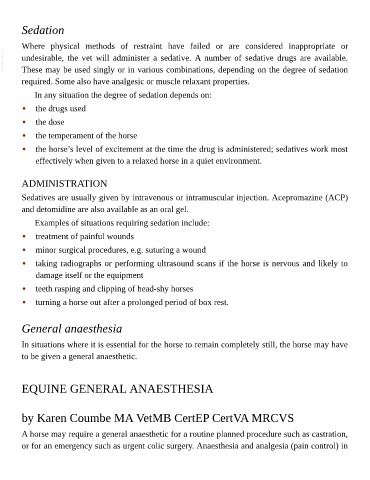Page 1086 - The Veterinary Care of the Horse
P. 1086
Sedation
Where physical methods of restraint have failed or are considered inappropriate or
VetBooks.ir undesirable, the vet will administer a sedative. A number of sedative drugs are available.
These may be used singly or in various combinations, depending on the degree of sedation
required. Some also have analgesic or muscle relaxant properties.
In any situation the degree of sedation depends on:
• the drugs used
• the dose
• the temperament of the horse
• the horse’s level of excitement at the time the drug is administered; sedatives work most
effectively when given to a relaxed horse in a quiet environment.
ADMINISTRATION
Sedatives are usually given by intravenous or intramuscular injection. Acepromazine (ACP)
and detomidine are also available as an oral gel.
Examples of situations requiring sedation include:
• treatment of painful wounds
• minor surgical procedures, e.g. suturing a wound
• taking radiographs or performing ultrasound scans if the horse is nervous and likely to
damage itself or the equipment
• teeth rasping and clipping of head-shy horses
• turning a horse out after a prolonged period of box rest.
General anaesthesia
In situations where it is essential for the horse to remain completely still, the horse may have
to be given a general anaesthetic.
EQUINE GENERAL ANAESTHESIA
by Karen Coumbe MA VetMB CertEP CertVA MRCVS
A horse may require a general anaesthetic for a routine planned procedure such as castration,
or for an emergency such as urgent colic surgery. Anaesthesia and analgesia (pain control) in

